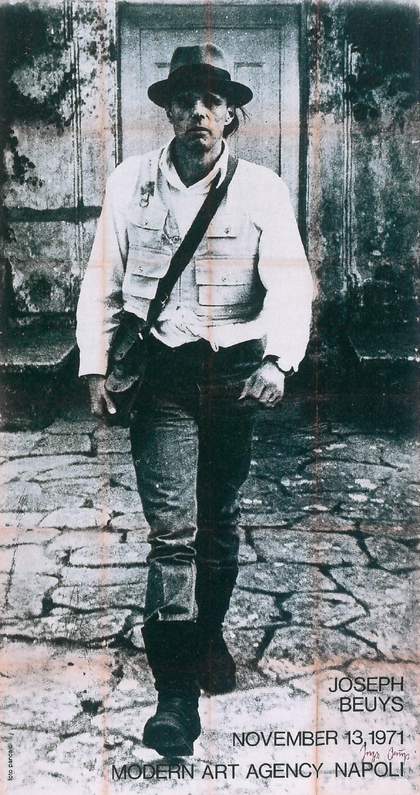
Fig.1
Joseph Beuys
Poster for the exhibition La rivoluzione siamo Noi at Modern Art Agency, Naples, 1971
© DACS 2019
According to the Neapolitan gallerist Lucio Amelio, Italy represented Joseph Beuys’s ‘ideal of a country where nature is mighty and abundant, where the sun is the source of all imagination’.1 This was especially the case for the relatively poor, less developed region of the Mezzogiorno. Beuys felt that unlike the industrialised societies of northern Italy, the agricultural civilisation of the Mezzogiorno had retained its primal, archaic structures and special, subterranean power constellations, formed from the intertwined cultural legacies of the Celts, Phoenicians, Saracens and Normans in present-day Puglia and Sicily.2 He was convinced that the people of this region had the qualities that would be needed in the future to shape a humane society. His enthusiasm for the Mezzogiorno and its people went back to the time when he was stationed in Puglia as a young soldier in 1943, during the Second World War, as well as to a stay he took in Naples around this time. This enthusiasm had not dimmed by 1971 when Beuys returned to Naples for the first time since the war for his solo exhibition La rivoluzione siamo Noi (We are the Revolution; fig.1) at Amelio’s gallery. As Amelio described it, this felt to Beuys like coming home. He was back in the city where ‘he had once been happy, a long time ago’.3
Beuys first met Amelio in 1971, and the gallerist soon became one of the most influential people in Italy for Beuys. Amelio’s German language skills meant that he could offer the artist access to the local art scene. When Beuys began to move the majority of his artistic activities to Italy from the 1970s onwards, this was primarily organised and arranged by Amelio, which helped to consolidate Beuys’s position in the Italian art world.4
Scholars of Beuys have drawn comparisons between his enthusiasm for Italy and the German Romantic perspective of the nineteenth-century encyclopaedic traveller, as well as of those travelling to Italy in the 1950s who had a renewed yearning for places such as Capri, Naples and Rome.5 But while their ‘wanderlust’ was mostly an expression of a search for an arcadian world, or was motivated by the desire to visit sites of cultural heritage, Beuys’s interest was not in visiting the ancient sites, museums or churches of Italy, either during his deployment in 1943 or during his later visits. He was not drawn to a time long lost, but rather to the vital energy that he believed emanated from past traditions and into the present, and he felt that this energy was particularly palpable in the Mezzogiorno and carried with it the promise of the creation of a humane society.
However, Beuys’s view by the end of the 1970s was that the politicians in the Mezzogiorno had consistently failed to create adequate living conditions for its population. This situation was exacerbated by the catastrophic earthquake that hit the city of Irpinia and the mountainous, volcanic region surrounding Naples on 23 November 1980, claiming over 2,400 lives and leaving thousands injured or homeless. Beuys felt that to address the region’s issues, a new approach had to be found that would turn it ‘back into a happy region’, into ‘fertile ground for creativity’, and that would give the area’s social structures a new direction.6
This attitude was aligned with the activity of the left-wing Italian group Lotta Continua (meaning ‘continuous struggle’). The group was founded in 1969 by the philosopher Adriano Sofri and the writer and activist Giorgio Pietrostefani and was dissolved in 1976. In the early 1970s Beuys got to know members of Lotta Continua via Amelio, and became friends with Checco Zotti, who was on the group’s editorial board. While Beuys distanced himself from Marxism and more extreme left-wing positions, he agreed with the group’s fundamental critique of the capitalist system and maintained friendly relations with group members. Through his collaboration with the Greens in the 1970s, Beuys was also in contact with Marco Pannella, a founding member of Partito Radicale, which had assumed a radical-democratic opposition role in Italy from the 1970s onwards.7
What follows here is an exploration of how Beuys sought, by means of his artistic-political activities in the Mezzogiorno, to ignite revolutionary change as an artistic process that encompassed the creative work of man in all areas of art, science and social life. The discussion focuses on the action sculpture Terremoto (Earthquake), which Beuys installed in the Palazzo Braschi in Rome on 7 April 1981, and on the installation Terremoto in Palazzo (Earthquake in the Palace), which Beuys created in Naples on 17 April 1981 in the gallery owned by Lucio Amelio; the paper also discusses Terremoto in Palazzo’s associated actions Diagramma Terremoto (Earthquake Diagram) and Vestito Terremoto (Earthquake Clothes).8 These works commemorated the Irpinia earthquake and are indicative of Beuys’s cultural-political thinking, exemplifying the process he was striving to establish in which critical reflection and artistic praxis could combine and interact. Convinced that social change could only be instigated by art as the sole revolutionary force, Beuys sought to activate human beings as the dynamic bearers of change, working towards a society founded in self-determination and freedom. As will be shown here, he aimed to create a ‘revolutionary earthquake in people’s minds’ through art’s catalytic impact.9
Terremoto
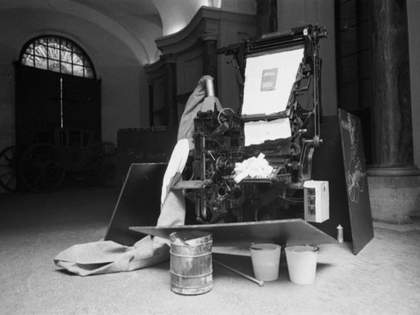
Fig.2
Joseph Beuys
Terremoto 1981, installed in the Palazzo Braschi, Rome, 1981
Solomon R. Guggenheim Museum, New York
© 2018 Artists Rights Society (ARS), New York/VG Bild-Kunst, Bonn
Photo © Tano D’Amico
At the core of Beuys’s sculptural work Terremoto is a Linotype Blue Streak Comet line casting machine (fig.2).10 With this semi-automatic contraption, lines of type can be formed in lead and then typeset to create layouts for printed material. Beuys applied a thick layer of fat to the keyboard of the machine and pasted the 1978 brochure Aktion Dritter Weg – Aufbauinitiative (Third Way Action – Building Initiative) to its steep magazine (typesetting area). This brochure details ideas for the realisation of democratic rights for all people and was published by the Achberger Institute for Social Science, which, like Beuys, subscribed to anthroposophy – the spiritual belief in individual freedom. According to Beuys, the Third Way Action would ‘become the instrument for people to engage in the broader tasks of renewing and humanising our civilisation through continuing theoretical work, model-based practice at the level of institutional alliances and political engagement’.11
Attached to the side control panel of the typesetting machine is ‘Aufruf zur Alternative’ (‘Call for Alternatives’), a text published by Beuys and the anthroposophists Peter Schata and Wilfried Heidt in the newspaper Frankfurter Rundschau on 23 December 1978, which in a summarised form sets out Beuys’s political programme for reforming society.12 From the vent pipe of the melting furnace, which normally emits harmful lead vapours from the machine, the Italian national flag, rolled in felt, emerges and drapes down on to the ground. Eight blackboards with diagrams and drawings lean unsteadily against the machine, and a ninth board is propped up against a large metal bucket which occupies the position where the typesetter would sit. This bucket is the typesetter’s waste bin, which Beuys filled with fat and faulty lead letters.
Terremoto developed from Beuys’s commitment to the left-leaning newspaper Lotta Continua, with whose editorial staff he had been on friendly terms since the early 1970s. His association with the paper and its political group of the same name may appear to contradict his consistent and strict rejection of Marxist theories of class struggle; yet Lotta Continua had caught Beuys’s attention due to its search for ideological alternatives to extreme left-wing positions held in Italy at the time by organisations such as the Stalinist Partito Comunista, the Potere Operaio and the Brigate Rosse. When Lotta Continua was in financial difficulty, Checco Zotti asked Beuys for help, encouraged by the fact that the artist had repeatedly supported press organisations and institutions out of solidarity. In response to Zotti’s request, Beuys took a spontaneous trip from Düsseldorf to Rome on 4 April 1981, without knowing what the editors were planning. Meanwhile, they collectively deliberated on how Beuys could assist the group.
Beuys, who was happy to receive suggestions from others, immediately took up the proposal put forward by Adriano Sofri, one of the founders of Lotta Continua, that Beuys should buy the typesetting machine. The newspaper was selling it as one way of helping to relieve its financial pressures, and also as a result of technological changes at this time that saw publishers moving from metal type to the faster phototypesetting process, which used photographic negatives rather than lead. The machine was promptly acquired and rebuilt by Beuys, and was accompanied by the old metal bucket containing leftover letters. It was transported the following day to the Palazzo Braschi in Rome, where on 7 April Beuys turned it into Terremoto in front of an audience by adding the various objects and materials described above to its exterior.
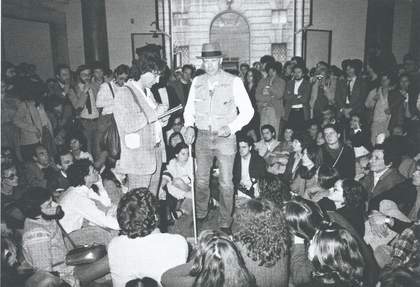
Fig.3
Checco Zotti and Joseph Beuys engaged in discussion with the audience, Palazzo Braschi, Rome, 1981
Photo © Tano D’Amico
The Italian photographer Tano d’Amico, whom Beuys had asked to document the creation of Terremoto, described how the artist started by walking around the machine several times, as if in a duel. Beuys then threw several kilograms of butter, shaped into cylinders, at the keyboard.13 At one point, having been interrupted by questions from the audience, Beuys asked them to leave the room so that he could continue to work in solitude. The waiting crowd regained access after the completion of the sculpture in order to discuss the concept with the artist. Beuys spoke in a mixture of Italian and German, which was translated by Zotti, who also moderated the debate (fig.3).
The blackboards that accompany the line casting machine help to explain, by means of language and imagery, Beuys’s theme: the Irpinia earthquake and its devastating effects. With delicate chalk strokes he had drawn onto these boards several skulls and heads in profile or in frontal view, with some seemingly threaded on a chain, and others appearing superimposed in a chaotic arrangement. Several of the faces express pain and suffering, with mouths wide open, mournfully recalling the earthquake’s horror and destruction.
On the blackboard that leans against the typesetter’s waste bin Beuys drew two circles connected by a straight line. He labelled them as Saturn and Jupiter, thus representing the conjunction of two celestial bodies. According to cosmological belief, such a constellation, which occurs every twenty years, enhances the effectiveness of planetary energies and signals an extraordinary event, such as the birth of a king or a saviour, but also apocalyptic natural disasters, such as a deluge or earthquake. In the literature of antiquity and the middle ages, the languid planetary god Saturn, the ‘demon of opposites’, represented death because he was ‘furthest from the source of life – the Sun’.14 In conjunction with the higher deity Jupiter, however, Saturn’s demonic powers were reduced, and Saturnian chaos would be directed into more ordered paths. Thus, the chalkboard could be read as an allusion to the artist’s concern for bringing order to the social and political chaos in the Mezzogiorno, and his desire to reinstate balance.
The name of Saturn, according to alchemical ideas that Beuys used repeatedly in his work, is assigned to the lowest metal, lead, which is indispensable for a line casting machine. With the keyboard covered in grease, a soft, organic material is contrasted with a hard, metallic one. Here the relationship of the amorphous to the solid, crystalline form corresponds – according to Beuys’s material iconography – to the opposition between reason and intuition.15 This is further reflected in the seemingly rational activity of the typesetter, who uses a machine to produce texts that originally emerged from a creative process.
In the line casting machine, the lead is first melted in a crucible and then poured into rows of moulds. Alchemy involved metals such as lead being melted by fire and then moving from liquid into solid form, a process that was intended to purify them and transform them into more ‘noble’ metals, such as gold.16 This method is associated with the Latin phrase ‘Solve et coagula!’, which broadly translates as ‘loosen and unite’. According to alchemical doctrine, ‘coagulatio’ describes not only the transformation of the material into a solid, but also the embodiment of the spirit in a solid form. This is seen in the line casting machine, where words are solidified in lead type and the power of ‘coagulatio’ is documented by the printed text.
On one of the blackboards, an enigmatic figurative head stands out, with flames on its elongated tongue. The ‘lingua di fuoco’ (‘tongue of fire’) is associated in the Italian language with a sharp accusation or biting words. Beuys added onto the board the Italian phrase ‘Apri bene la bocca’, which means ‘open your mouth wide’ and tell the truth. After the earthquake and the failure of the politicians to provide quick relief for those in need, this exclamation could be seen to function as a political appeal.
This imagery called for reflection and repentance within the misguided political system of the Mezzogiorno, a request reinforced by Beuys’s inclusion in the sculpture of a copy of his ‘Call for Alternatives’, which aimed to equip the people with new energy and a sense of solidarity. Furthermore, in Terremoto the Italian flag is symbolically charged with an energetic force through the warmth-giving power of felt. As a further act of solidarity, Terremoto was sold at auction two days after it was made, and Beuys donated the proceeds to support the newspaper Lotta Continua.17
Terremoto in Palazzo
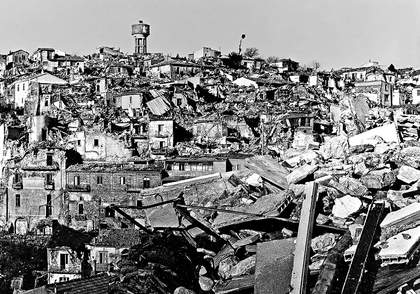
Fig.4
Giuseppe M. Galasso
View of the destroyed city of Irpinia, November 1980
Photo © Giuseppe M. Galasso
On 16 April 1981 Joseph Beuys responded with harsh words to the political non-reaction to the effects of the Irpinia earthquake that had taken place the year before (fig.4). He said:
The earthquakes in the palaces continue. The physical quakes in the many villages and small towns of Mezzogiorno and in the metropolis of Naples have claimed numerous lives, which we must always remember if we want to achieve radical change through our reconstruction efforts; at the same time, these tremors are reflected in the indescribable, ongoing structural collapses in the private capitalist palaces of the West and the state capitalist palaces of the East. Pericolo di crollo! [Danger of collapse!] These palaces will never deliver help for the people, all they will do is extend the death zone into nature itself.18
He set out his accusations in the article ‘Some Demands of, and Questions About, the Palace Inside the Human Head’ (‘Alcune richieste e domande sul Palazzo nella testa umana’),19 which was written for the centre-left Neapolitan paper Il Mattino. The article describes what Beuys saw as the inexcusable social and political conditions in southern Italy at the time; this is followed by an elucidation of the social changes Beuys envisaged – changes founded in his concept of the revolutionary potential of art and creativity. However, Il Mattino declined to publish the article because of the radical nature of the political demands it made.
In keeping with the parallel process Beuys was striving for – namely, the equality of aesthetic production and conceptual discourse – the text of this article became an integral part of the large-scale installation Terremoto in Palazzo, which was first presented at Lucio Amelio’s gallery in Naples on 17 April 1981. The making of the installation was prompted by an initiative on the part of Amelio in which he called for international artists to create works responding to the tragedy in Irpinia. Beuys was one of the first artists to put himself forward for the project, which aimed to send a positive message that could counter people’s despair in this catastrophic situation.20 Yet the image of instability that Beuys presented in his installation worked to illustrate the existential vulnerability of humankind when it is endangered by the destructive forces of nature. At the same time, the installation was an allegory of the disastrous political conditions in the Mezzogiorno.
The regions of the Mezzogiorno that were hit particularly hard by the earthquake were Campania (where Irpinia is located) and Basilicata. Because of the geological conditions of these areas, the lives of the local people were overshadowed by a constant feeling of insecurity. Continuing economic underdevelopment, a wholly inadequate infrastructure and corrupt governing authorities and politicians also served to undermine the psycho-social order.21 After the earthquake, only a fraction of the donations that came from across the world reached those affected, as local politicians and organised criminals helped themselves to these funds by creating bogus building projects.22 Faced with the social realities of the region, Beuys was eager not only to show the people there his solidarity and compassion, but also to demonstrate the possibilities available to them through their right to self-determination and their innate strength.

Fig.5
Joseph Beuys
Terremoto in Palazzo (detail) installed at the Modern Art Agency Naples, 1981
Photo © Mimmo Jodice
In February 1981, three months after the earthquake, Beuys and Amelio travelled to the affected sites together to gather testimonials from people who had lived there before the disaster. They were also on the lookout for artefacts from the local working environment that could be incorporated into Terremoto in Palazzo. The objects they found included a blacksmith’s workbench, a shoe-shiner’s footstool with drawers, and two tables, all of which were delivered to Amelio’s gallery by a transport company. Beuys then left these items in more or less the exact positions in which they had been placed when they were delivered – a method he often used when setting up installations. His only intervention in terms of their position was to move the two tables to the edges of the room and wedge a clay pot between each table and the wall. The slightest movement would have sent the pots crashing to the floor, as was the case with the workbench that Beuys balanced on four glass jars, one for each leg (fig.5).
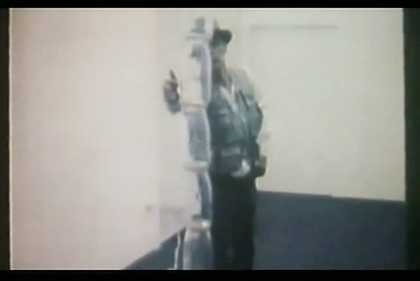
Fig.6
Film still from Mario Franco’s Diagramma Terremoto (Joseph Beuys, Naples 1981) 1997, showing Joseph Beuys performing Diagramma Terremoto in Naples, 1981
© Mario Franco
Two further clay pots on the footstool and an egg on the workbench were also positioned in a fragile equilibrium. The egg, traditionally a symbol of new creation, offered a stark contrast to the image of destruction and decay provided by a pile of broken glass that sat on the floor nearby. The broken glass was in fact the remains of a pillar of jars that Beuys had built but which collapsed a few minutes later, possibly by mistake, as can be seen in Mario Franco’s film Diagramma Terremoto (fig.6). The clay pots and the egg would also have fallen and smashed at the slightest touch, just as the glass had done. Beuys may have included an egg here not only as a symbol of creation but also as a reference to the Castel dell’Ovo – the Castle of the Egg – which was the fort overlooking the harbour in Naples. The oldest fortification in the city, the Castel dell’Ovo was a stone’s throw from Amelio’s gallery at the Piazza dei Martiri and very close to where Beuys would stay on his trips to Naples. According to the city chronicle of 1382, the Cronaca di Partenope, the Roman poet Virgil gave a magical egg to the fort in the first century BC; that egg was subsequently hidden in a vessel in a secret location in the walls of the fort. It was believed that the fate of the Castel dell’Ovo and of the city of Naples were linked to that egg and they would not fall ‘as long as the egg remains as it is’.23
The fragility of the glass and the delicate balance of the other objects in Terremoto in Palazzo alluded to the precarious existence of the people living in the earthquake-stricken part of the Mezzogiorno. According to Beuys, Terremoto in Palazzo showed a world that had ‘outlived itself’;24 it reflected the failure of social structures in the crisis-shaken city of Naples, where the rich and the powerful saw even a devastating event like the earthquake as an opportunity for personal gain. The artist regarded the politicians in their palazzo as being neither able nor willing to improve the prevailing, indefensible social and political conditions in southern Italy.25 As Beuys argued in his article ‘Some Demands of, and Questions About, the Palace Inside the Human Head’, the people could expect neither a move towards greater security or freedom, nor the safeguarding of basic human rights, nor the fostering of an economy geared towards promoting the common good. He therefore called for a decentralisation of the state and for the autonomous administration of individual regions, as well as for disengagement from the central government in Rome, from NATO, and from the political control of the European Economic Community.26
From devastation to optimism
Despite his strong political emphasis in Terremoto and Terremoto in Palazzo, Beuys was not only concerned with drawing attention to the destructive natural forces, the misguided politics in the palaces, and the resultant suffering of the people of the Mezzogiorno. His main interest was in overcoming the terrible experience of the earthquake and the untenable social situation while drawing a positive conclusion from both. For Beuys, the crucial precondition for the creation of a humane society would be a revolutionary quake in the people’s minds – ‘[that] palace we will have to first conquer and then inhabit in a worthy manner’.27 By applying the term ‘palace’ to an anthropological entity, he invested it with a spiritual dimension, portraying the human head as the most valuable ‘palace on earth’, as a symbol for cognitive strength, willpower and the ability to make decisions.28 A fundamental change in thinking, free from capitalist and Marxist ideologies, would be required if the state palaces were to be toppled, and the vital precondition for this would be a politics based on reason, geared towards satisfying human needs and democratising public life. This alone could bring about the necessary changes in society.
As Beuys said to curator and critic Michele Bonuomo in his last interview, for this to take place the balance between reason and intuition first needed to be reinstated. Bringing these two forces into harmony, so that humanity would no longer be governed solely by its intellect, was one of Beuys’s primary concerns.29 He saw the energetic forces released by the physical quake as a chance for regeneration, and equated the vitality inherent in nature with man’s creative powers. Just as nature had been shaken by tremors, the human soul would be brought into vigorous movement, so that it would become possible to instigate change. According to Beuys, the explosive potential of volcanic energy could be seen as a metaphor for warmth – for what he called a ‘warmth sculpture’, in which the artwork possesses the emotional qualities of human empathy, as opposed to the coldness of intellect or reason. By positively transforming the volcanic element through a creative process, human beings might just find the strength to change their circumstances.
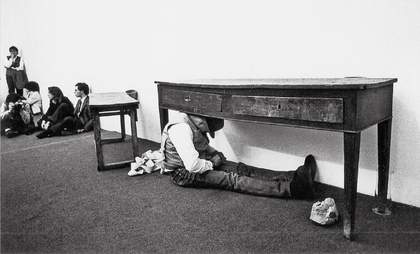
Fig.7
Joseph Beuys performing Terremoto in Palazzo at the Modern Art Agency Naples, 1981
Archivio Amelio-Santamaria
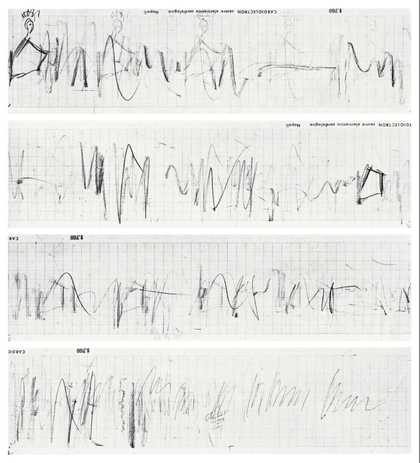
Film still from Mario Franco’s Diagramma Terremoto (Joseph Beuys, Naples 1981) 1997, showing detail of Diagramma Terremoto in Naples, 1981
© Mario Franco
The transformative energy of nature was also the guiding theme of Beuys’s two actions at the opening of Terremoto in Palazzo. The first action, Diagramma Terremoto, visualised the positive transformation of the ‘catastrophic elements’ through the medium of drawing.30 The artist sat underneath the largest of the wooden tables in the installation, drawing pencil lines of different shades and shapes on a roll of paper. The paper was thirty-four metres in length and was taken from an electrocardiogram (ECG) machine, and Beuys gradually unrolled it as he drew (fig.7). Acting as a human seismograph, Beuys was absorbed in tracing the vibrations of an imagined earthquake in the same way that an ECG machine records the electrical activity of the human heart (fig.8). He saw himself as an ‘antenna’, detecting the ‘fiery energy burning in the earth’s core’.31 It was as if the artist was reproducing the fluctuating phases of relative calm and volcanic energy that were also seen in the political and economic conditions in the Mezzogiorno at the time.

Fig.9
Film still from Mario Franco’s Diagramma Terremoto (Joseph Beuys, Naples 1981) 1997, showing detail of Vestito Terremoto in Naples, 1981
© Mario Franco
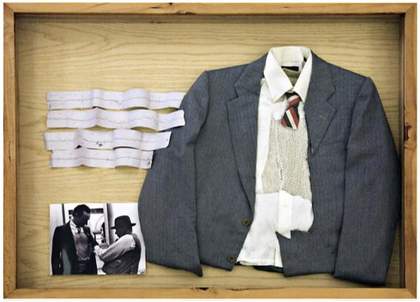
Fig.10
Joseph Beuys
Vestito Terremoto
Collection Gino Battista, Triggiano
© DACS 2019
By this time Beuys saw art as having reached a point at which the totality of reality was no longer representable. He therefore called for artists to integrate a ‘volcanic element’32 into their concepts, in order to shatter artistic boundaries and include the human being in the creative process. ‘The artist is a catalyst of individual creativity’, Beuys stated; one who works to realise the idea of social sculpture and to expand on the concept of art.33 Beuys demonstrated the therapeutic function of art in Vestito Terremoto, his second action at the Terremoto in Palazzo opening, in which he cut holes in Amelio’s jacket, sweater and shirt, and then protected these with rubber netting. Next he placed ECG electrodes on Amelio’s skin, recording his heart rate, which was logged on ECG paper (figs.9 and 10). In doing so Beuys acted as a healer and therapist to his friend, who did in fact have a cardiac problem that he was extremely worried about, and for which he already wore an ECG. At the same time, the artist established a connection to the ‘seismographic’ recordings he had made in the Diagramma Terremoto action, comparing the rhythm of the heart muscle to the tectonic tremors of the earth, all the while regarding the energetic forces of these tremors as a positive impulse in the creative process.
As we have seen, in the 1970s and 1980s Beuys developed the optimistic conviction that the people of southern Italy possessed a primal, existential vitality. This led him to believe that they – if no one else – would be able to resist unjust social conditions and fight against the destruction of the environment and the exploitation of natural resources. For Beuys, it was here that an idea of community still existed, ‘unlike other European countries, where this idea had been destroyed by Capitalist egoism, Americanisation and industrialisation’.34 If the idea of the human being as an artist, as the creator of an entire field of work, could be put into action in southern Italy, it could even serve as a model for other countries and social systems.35
By initiating a cultural earthquake that harnessed the revolutionary power of creativity, the permanent disaster gripping the Mezzogiorno region could, in Beuys’s view, be overcome. As reflected in Terremoto and Terremoto in Palazzo and its attendant actions, Beuys believed that an alternative politics and the involvement of all people in shaping the future of the region would bring about the urgently needed change in conditions in southern Italy. As the ‘highest beings’ and the ‘bearers of the spirit’, human beings possessed the power of self-determination and therefore should not leave the organisation of the world up to career politicians and undemocratic systems. As Beuys stated: ‘Humans, you have the power to determine your own fate.’36
